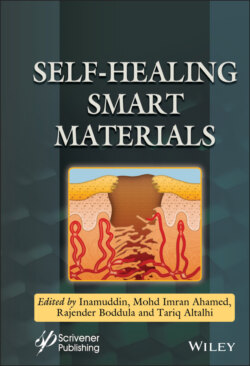Читать книгу Self-Healing Smart Materials - Группа авторов - Страница 38
3.3.3 Polybutadiene Rubber
ОглавлениеThe other important synthetic rubber in the tire industry is polybutadiene rubber (BR) due to his high resistance to wear and low rolling resistance.
Xiang et al. analyzed samples of BR compounded with a liquid polysul-fide that provides disulfide bonds and thiol end groups [54]. The curing (vulcanization) and self-healing processes was promoted through UV radiation at room temperature. The authors emphasize that a photo induction method requires less energy than that based on thermal activation. A disulfide metathesis by including diethyl disulfide (DEDS) and dibutyl disulfide (DBDS) was used due to this mechanism is promoted by the UV radiation and the metathesis was characterized at different irradiation intensities and time intervals. The amount of the liquid polysulfide was varied between 50, 100 and 150 g in 100 g of rubber, naming the compounds B1S5, B1S10 and B1S15 respectively. Through gas chromatography–mass spectroscopy it was observed that increasing the UV intensity the time require to reach the metathesis equilibrium diminishes and the optimum value for curing was determined in 20 mW/cm2.
The self-healing was evaluated through tensile tests: after the failure the samples were put in physical contact and a radiation intensity of 20 mW/ cm2 was applied during 3 h. It was found that the compound B1S10 reaches the highest healability with an efficiency of ~60 %. Then, in this compound were applied different intensities between 5 and 40 mW/cm2 for 2 h, determining that the optimum intensity is 30 mW/cm2 as can be seen in Figure 3.15a. Then with that radiation amplitude the exposure time was varied from 0.5 up to 3 h, founding that the healing efficiency increases with the time, reaching a 97% (Figure 3.15b). Due to the reversibility of the disulfide metathesis the healing mechanism can be applied more than once. As can be seen in Figure 3.15c, efficiency higher than 90% is maintained even after the third cycle of healing.
Given the outstanding obtained results, the authors advanced in applying the optimum self-healing protocol (30 mW/cm2, 3 h) in a grounded sample of the B1S10 compound in order to reprocess it and enabling to obtain a material with a different shape as is schematized in Figure 3.16. The recycle efficiency (the recovery degree in the mechanical properties after one treatment) decreases with the process: an efficiency of 82% is obtained when the reclamation is made once, but diminishes up to 64% after the third reclamation cycle. This process also depends on the mesh size due to when the particle is smaller the available surface to react is higher.
Figure 3.15 Tensile strain measurements to characterize the self-healing process induced by UV-radiation varying the following conditions: (a) intensity, (b) interval time. (c) Repeated self-healing when the sample was irradiated with 30 mW/cm2 during 3h (Adapted with permission from Xiang et al. [54]).
Figure 3.16 Process followed to the sample reclamation (Adapted with permission from Xiang et al. [54]).
